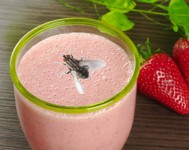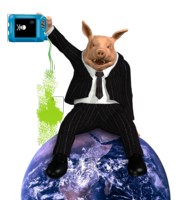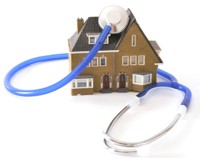What Are We Doing? Do We Even Know?
 Wednesday, August 24, 2011 at 12:52PM
Wednesday, August 24, 2011 at 12:52PM  This morning, as I was drinking my Vanilla EAT! shake made with almond milk, a bit of added fiber, some probiotics, and frozen strawberries, I saw a little black bug land right inside my frothy glass. I removed it. Then I consumed the entire shake . . . and I liked it.
This morning, as I was drinking my Vanilla EAT! shake made with almond milk, a bit of added fiber, some probiotics, and frozen strawberries, I saw a little black bug land right inside my frothy glass. I removed it. Then I consumed the entire shake . . . and I liked it.
Before I get further into the bug anecdote, let’s consider the provocative title of this piece. I posed two questions in the headline, and I’ll answer the second one.
Do we know what we’re doing?
Now I’ll answer my own question.
No. We don’t!
 We don’t know what we’re eating, we don’t know what we’re drinking, we don’t know what we’re breathing, and we certainly don’t know what we’re doing to our next generation.
We don’t know what we’re eating, we don’t know what we’re drinking, we don’t know what we’re breathing, and we certainly don’t know what we’re doing to our next generation.
OK, some of you are already offended. If that’s what it takes to get your attention, so be it. Let me explain my assertion by presenting two different categories of “we.”
There is the “we” that is mankind, those bound by human nature, those who learn by mimicking others, who find their place within organizations of like minded people, and those well-intentioned people can be either great providers . . . or can be manipulated into doing harm.
 Then there’s the other “we.” There is the “we” we know as the richest, the biggest, and the best, the “we” that, despite a lack of willingness to take required action, most people wish they could climb alongside of. It’s within this category that the problem lies.
Then there’s the other “we.” There is the “we” we know as the richest, the biggest, and the best, the “we” that, despite a lack of willingness to take required action, most people wish they could climb alongside of. It’s within this category that the problem lies.
Before I share my unsolicited societal commentary, let me identify the problem. There are three part of it.
- The air you breathe
- The food you eat and beverage you drink
- The shelter you choose to live in
I watched that bug land in my shake. I saw it, with my own eyes. I knew it was in there. Knowing there was something I didn’t want to ingest in the shake I was about to drink gave me a great power. The power to remove it.
I know what’s in my EAT! formula as I formulated it, I buy the raw materials, I have very strict guidelines and I require an assay on every new batch. I know the purity of the fiber I use. I know the source of my probiotics. I buy frozen organic strawberries from outside of the U.S., and with all of that energy and effort, I’m still unsure what is in there that I can’t see.
Are the strawberries really organic? Were pesticides ever used on the soil in which they were grown? Were they picked under sterile conditions? Is the container of almond milk manufactured with phthalates or BHA’s? What are those? I’ll get to it. Bear with me.
I know I’m starting to sound paranoid. I’m not. I’m more aware than ever, and while I don’t pretend to have the answers, I do now know enough to help people make better decisions, and hopefully stimulate some action that leads to a healthier environment and with that a healthier population.
 When we talk about “environment,” we tend to think of the world outside. For the moment, consider your immediate environment, the home you live in. It may not be as friendly as you believe.
When we talk about “environment,” we tend to think of the world outside. For the moment, consider your immediate environment, the home you live in. It may not be as friendly as you believe.
I have tested the air quality in my two year old home and found formaldehyde levels are excessive. I just saw a commercial that tries to discourage people from cigarette smoking by showing a young girl in a classroom asking her male classmate if he’s going to drink the embalming fluid the frog he’s dissecting is immersed in. It follows with a tag, “cigarettes contain formaldehyde.” That’s intended as an acceptable deterrent. Nobody would argue the dangers of smoking.
Here’s the scary part. The formaldehyde in my home, and in almost all new construction homes built after 2000, has nothing to do with cigarettes. It’s emitting from the paint, from the carpet, from the drywall, from the insulation, from the pressed wood cabinet shelves, and from the furniture. I wouldn’t drink frog embalming fluid, but being unaware of the chemicals in my home, I inhaled the toxic chemical that is being used to dissuade people from smoking.
Formaldehyde is only one of the toxic aldehydes, and they’re used in almost all building materials, even lumber you might purchase at a lumber yard.
At this point you might dismiss me with the words, “aldehydres smaldehydes” (OK, maybe few people would use those words but you might use other words to dismiss me). After all, you’ve lived in your home or apartment and haven’t gotten ill.
In my A.L.I.V.E. seminar I reframe the concept of disease. Disease is a continuum. Most people think they’re “sick” on the day they’re diagnosed, but diseases are self-perpetuating, and they start with microtrauma at a cellular level. You can see the bug in the drink, but you can’t see the oxidative stress taking place in your body. I’m suggesting, we, as a population, can significantly reduce the epidemic of inflammatory disease, cancer, brain disease, circulatory disease, and respiratory disease if we become proactive, first as individuals, then as clusters of people, and finally in a widespread population change.
One of the top doctors in Environmental Medicine, Dr. William Rea, uses the metaphor of a rain barrel. When our detox systems are functioning well, we can eliminate many of the toxins we are exposed to, but once the level of oxidative stress exceeds “the rim,” all of those chemical toxins become firstly disruptive, and then cellular poisons. Rarely will someone with cancer be told it might have been perpetuated by the cosmetics they used, but evidence is mounting to show indisputable correlations.
So far I mentioned only formaldehyde as “the bug in the drink you can’t see,” but here’s a tiny sampling (this could be the beginning of a virtual encyclopedia as 1500 new chemicals are released into the environment every year) of the chemicals “regular people living regular lives” are exposed to daily:
¡ Oxybenzone (cosmetics, creams, moisturizers) – disrupts hormonal levels. 97% of Americans have potentially harmful levels based on a large scale urine sampling
¡ Fluoride (toothpaste, tap water) – Previously accepted levels have been evidenced to have neurotoxic effects
¡ Parabens – (preservatives used in non-edible consumable products like shaving cream and hair products) – causes severe hormone disruptions in animals and recent animal studies show a depressed resistance against cancer
¡ Phthalates – (chemicals that make plastics soft and resilient found in toys, food packaging, plastic containers, cosmetic packaging, household product wrapping) - increases in estrogen, reduction in testosterone, reduced sperm count, and increased likelihood of liver cancer.
¡ Butylated Hydroxyanisole (BHA) – (added to extend shelf life of snack foods, chewing gum, and packaged baked goods) – promotes development of cancer cells
¡ Perfluorooctanoic Acid (PFOA) – used in teflon cookware and found in tap water. Research shows radical endocrine shifts and animal research shows reproductive abnormalities. Found in increasing levels in the environment and in human blood.
¡ Perchlorate – (an oxidative compound used in rocket fuel, flares, and found in tap water, bottled water bottled in the U.S., soil, vegetables grown under standard farming practices in the U.S., and cow’s milk from cows feeding on perchlorate-ridden grasses) – disrupts thyroid function, damages cellular membranes, slows metabolism.
¡ Decabromodiphenyl Ether (DECA) – (a flame retardant used in electronics, furniture, carpet) – proven to lead to irreversible cognitive impairment and memory loss as well as decreased sperm count.
So what can you do? I’m going to develop a portal, an informational site where you can learn to make better choices, to protect yourself, and to create awareness. I’ve already recruited some of the top experts from the fields of environmental medicine and research science to contribute to this site. You’ll learn to find and select foods, cosmetics, and products that are as close to toxin-free as we can get, and as the demand for these products increases, manufacturers will be forced to change common practices.
 I know what some of you are thinking. “I already buy “green.” Green is a term given to the Al Gore driven theories, and in some cases I’d have to say facts, related to global warming, but “protecting the planet” has little to do with “protecting the people.” We need to understand that our planet is a biological wonder, but so too is each of our bodies, and as we drift further away from natural balance, we can only do harm. Start by protecting yourself, and then, collectively we’ll protect the ozone layer.
I know what some of you are thinking. “I already buy “green.” Green is a term given to the Al Gore driven theories, and in some cases I’d have to say facts, related to global warming, but “protecting the planet” has little to do with “protecting the people.” We need to understand that our planet is a biological wonder, but so too is each of our bodies, and as we drift further away from natural balance, we can only do harm. Start by protecting yourself, and then, collectively we’ll protect the ozone layer.
I don’t want to veer toward being political, but I do want you consider a few realities. I’ll pose them as questions:
Why is autism so commonplace today?
Why is ADHD now an acceptable diagnosis for “regular kids?”
Why do they need a peanut free section in my daughter’s school cafeteria?
These weren’t concerns when I was in school. Our innate biology hasn’t changed, so obviously something environmental has.
I present these questions, right now, as simple food for thought. I can follow with questions about hormonal disruptions, type 2 diabetes, and the emergence of new auto-immune diseases, and I will in weeks and months to come. I have seen enough, first hand and through credible science, to know that we need change.
This is an introduction to what I hope escalates into a movement. There’s an irony to this. I’ve devoted my life and career to helping people get fit and healthy. In 2005, having never personally dealt with illness, I was exposed to toxic levels of mold and I’m left with a debilitating condition called Multiple Chemical Sensitivity. I feel as if that was a warning, as if I now have an enhanced awareness and direction, and as I speak to more people, I find more people who are chemically sensitive to the point that this appears to be heading toward the next epidemic.
I continue to share the fitness truth, and now it will be enhanced by helping people fully understand how to find and maintain health in the 21st century.
If you’ve experienced undue fatigue, digestive challenges, or changes in sex drive after moving into a new work or home environment, I’d love to know. If you’ve been diagnosed with something that “just doesn’t make sense,” let me know. If you find yourself suddenly offended by strong fragrances or perfumes, send me a note. Without putting that request out, I’ve already received over 300 emails from people who “didn’t quite know what was wrong,” ranging from “my mother sleeps all day since she moved into her new apartment” to “suddenly, I can’t stand the smell of my wife’s perfumes.” I’ve heard of misdiagnoses, crippling episodes of accidental exposures, and whole families, co-workers, or communities finding rare and odd outbreaks.
When we consider fatigue and reduced sex drive, these sound benign, perhaps psychological, but I’ve seen enough to know, these are only a few of the early symptoms that indicate a progressive negative impact by environmental toxins.
I invite your thoughts and comments.
If you care to know about my personal journey with mold illness and chemical sensitivity, visit:
http://aliveandbetter.wordpress.com
If you have interest in finding your own path to fitness, attend my next A.L.I.V.E. Webinar, available to 99 people worldwide via web and telephone. It isn’t specific to “toxins,” but rather to gaining control over your own health and fitness. The A.L.I.V.E. protocol is being revered by those who have experienced it, both as clients and as medical practitioners. Read more about A.L.I.V.E. here.
 Phil Kaplan |
Phil Kaplan |  1 Comment |
1 Comment | 